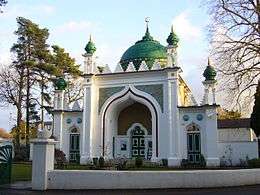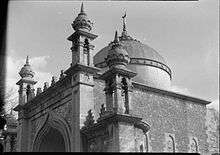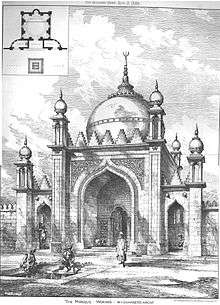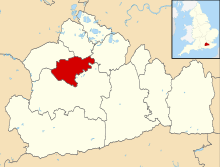Shah Jahan Mosque, Woking
| Shah Jahan Mosque | |
|---|---|
 | |
| Basic information | |
| Location | Oriental Road, Woking, England |
| Geographic coordinates | 51°19′18.5″N 0°32′51″W / 51.321806°N 0.54750°WCoordinates: 51°19′18.5″N 0°32′51″W / 51.321806°N 0.54750°W |
| Affiliation | Sunni Islam |
| Website |
shahjahanmosque |
| Architectural description | |
| Architect(s) | W. I. Chambers |
| Architectural type | Mosque |
| Architectural style | Persian-Saracenic architecture |
| Completed | 1889 |
| Specifications | |
| Dome(s) | 1 |
| Minaret(s) | 0 (2 miniature) |
The Shah Jahan Mosque (also known as Woking Mosque) in Oriental Road, Woking, England, is the first purpose-built mosque in the United Kingdom. Built in 1889, it is located 30 miles (50 km) southwest of London. It is a Grade I listed building.[1]
Construction


The Shah Jahan Mosque was built in 1889 by Hungarian-British Orientalist Gottlieb Wilhelm Leitner. It was partly funded by Sultan Shah Jahan Begum of Bhopal, as a place for students at the Oriental Institute in Woking to worship at. The mosque was designed by architect William Isaac Chambers (1847–1924) and built in Bath and Bargate stone. It was designed in a Persian-Saracenic Revival style, and has a dome, minarets, and a courtyard.[2] The architecture was described by Pevsner Architectural Guides as "extraordinarily dignified".[3]
The Oriental Institute, for the students of which the mosque was constructed, was founded by Leitner in 1881. He had purchased the former Royal Dramatic College building in Woking and established the Institute in order to promote oriental literature. It awarded degrees from the University of the Punjab in Lahore, Pakistan.[2]
History
The mosque became the first formal place of Islamic worship in England. Queen Victoria's British Indian employees and her British Indian secretary, Abdul Karim, used the mosque when the Queen visited Windsor Castle. A small number of dignitaries, students, and guests used the mosque until Leitner's death in 1899, following which the mosque closed.[2]
Ahmadiyya period
The mosque fell into disuse between Leitner's death and 1912. Khwaja Kamal-ud-Din, a prominent Kashmiri lawyer and founder of the Woking Muslim Mission, worked to repair and revive the mosque. Leitner's son wanted to sell the land to property developers so Khwaja took him to court on the grounds that the Mosque was consecrated ground just like a church and therefore deserved the same rights and property limitations.[4] He won and after purchasing the grounds from Leitner's son for a small price he was able to re-open the Mosque in 1913. It attracted royal visitors and famous British converts, such as Lord Headley and Marmaduke Pickthall. The mosque became a centre of Islam in the UK. During the First World War, the incumbent imam, Sadr-Ud-Din, petitioned the UK government to grant nearby land to the mosque as a burial ground for British Indian Muslim soldiers. By 1917, this burial ground had been constructed and received the bodies of 19 soldiers from the hospital for British Indian soldiers at Brighton Pavilion.[2]
Until the arrival of Pakistani immigrants in the UK in the 1960s, the Shah Jahan Mosque was the centre of Islam in Britain. It was from the mosque that The Islamic Review was published, as well as Maulana Muhammad Ali's - popular English translations of the Quran. It has also been claimed as the location at which the name 'Pakistan' was coined.[5] Among those that visited the mosque in this time were Faisal of Saudi Arabia, Muhammad Ali Jinnah, Haile Selassie, Mir Yousuf Ali Khan, Aga Khan III, and Tunku Abdul Rahman.[6]
Sunni period
By the 1960s, the influence of the mosque had declined and was seen more as a local mosque than vital to the practice of Islam in the UK. In the 1970s, it transferred into Sunni hands and was revived as an important place of worship in the community.[7] The mosque was badly damaged in June 2016 after floods swamped homes in the surrounding area.[8]
See also
References
- ↑ Historic England. "Shah Jehan Mosque, Oriental Road (Grade I) (1264438)". National Heritage List for England. Retrieved 12 March 2018.
- 1 2 3 4 "Shah Jahan Mosque, Woking". Exploring Surrey's Past. Retrieved 17 December 2016.
- ↑ "Shah Jahan Mosque". Woking Borough Council. Retrieved 17 December 2016.
- ↑ "History of the Mosque - Part 2 | Shah Jahan Mosque". www.shahjahanmosque.org.uk. Retrieved 2017-02-22.
- ↑ Glancey, Jonathan (17 June 2002). "The ideal dome show". The Guardian. Retrieved 17 December 2016.
- ↑ "The History of the Shah Jahan Mosque in Woking". Islam in British Stone. Retrieved 17 December 2016.
- ↑ "History of the Mosque - Part 3". Shah Jahan Mosque. Retrieved 17 December 2016.
- ↑ "Woking's Shah Jahan Mosque damaged in flooding". getSurrey. 11 May 2016. Retrieved 17 December 2016.
External links
| Wikimedia Commons has media related to Shah Jahan Mosque, Woking. |
- Website: Shah Jahan Mosque
- AAIIL: Woking Mosque and the Woking Muslim Mission
- BBC: Forty Eight Hours – Tour: Woking Mosque (Photo of the Mosque in the 1900s)
- British Muslim Heritage – London’s Mosques
- Historic England. "the mosque (427831)". Images of England.
- Historic England. "the entrance walls (427832)". Images of England.

